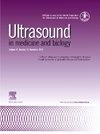Clutter-Generating Phantom Material. Part I: Development of a Tunable, Acoustic Clutter-Generating Layer for Use With Ultrasound Tissue-Mimicking Phantoms
IF 2.4
3区 医学
Q2 ACOUSTICS
引用次数: 0
Abstract
Objective
Acoustic clutter is a major source of image degradation for in vivo ultrasound imaging. However, clutter is often not represented in laboratory testing of ultrasound equipment. A phantom material is proposed that can be used to add calibrated amounts of clutter in the laboratory environment.
Methods
Previously, the speed of sound in agar has been adjusted by varying the concentration of propanol to which the agar is exposed. That property was leveraged in this work to create a phantom with an adjustable amount of clutter. Agar spheres were soaked in propanol solution, then strained and placed in mineral oil.
Results
Image quality measurements showed an approximate range of achievable contrast degradation levels of 15 dB. Stability studies with the phantom material showed that it can be stored for at least 21 d after the speed of sound tuning in propanol, but once introduced to mineral oil the clutter will change over time.
Conclusion
This work demonstrates a clutter-generating phantom material that can be used in conjunction with standard ultrasound imaging phantoms.
产生杂乱的幻影材料。第一部分:用于超声模拟组织的可调谐声杂波产生层的开发。
目的:声杂波是体内超声成像图像退化的主要来源。然而,杂波在超声设备的实验室检测中往往不存在。提出了一种可用于在实验室环境中添加校准量杂波的幻像材料。方法:以前,琼脂中的声速通过改变琼脂暴露的丙醇浓度来调节。在这项工作中,利用该属性创建了一个具有可调节杂乱量的幻影。琼脂球浸泡在丙醇溶液中,然后过滤并置于矿物油中。结果:图像质量测量显示可实现的对比度退化水平约为15 dB。对幽灵材料的稳定性研究表明,在丙醇中调整音速后,它可以储存至少21天,但一旦引入矿物油,杂波就会随着时间的推移而改变。结论:这项工作展示了一种可以与标准超声成像幻影结合使用的产生杂波的幻影材料。
本文章由计算机程序翻译,如有差异,请以英文原文为准。
求助全文
约1分钟内获得全文
求助全文
来源期刊
CiteScore
6.20
自引率
6.90%
发文量
325
审稿时长
70 days
期刊介绍:
Ultrasound in Medicine and Biology is the official journal of the World Federation for Ultrasound in Medicine and Biology. The journal publishes original contributions that demonstrate a novel application of an existing ultrasound technology in clinical diagnostic, interventional and therapeutic applications, new and improved clinical techniques, the physics, engineering and technology of ultrasound in medicine and biology, and the interactions between ultrasound and biological systems, including bioeffects. Papers that simply utilize standard diagnostic ultrasound as a measuring tool will be considered out of scope. Extended critical reviews of subjects of contemporary interest in the field are also published, in addition to occasional editorial articles, clinical and technical notes, book reviews, letters to the editor and a calendar of forthcoming meetings. It is the aim of the journal fully to meet the information and publication requirements of the clinicians, scientists, engineers and other professionals who constitute the biomedical ultrasonic community.

 求助内容:
求助内容: 应助结果提醒方式:
应助结果提醒方式:


